I only briefly played a friend's copy of the GB Metroid game. I had rented the NES Metroid game, but I didn't really get into the series until Super Metroid on the SNES.
Metroid II: Return of Samus Review Rewind
|
|
See PixlBit's Review Policies

On 09/15/2017 at 01:03 AM by Jamie Alston Back for the first time |

If you liked the concept of Metroid but found progression to be too challenging, this sequel provides a more balanced experience.
Nintendo is no stranger to making risky decisions that could have resulted in utter failure. After all, they released the Famicom\NES during a time when the consumer market shunned video games. Then there was that time in 2004 when most of us thought they were crazy when they announced the dual screen handheld DS. And many were skeptical when motion controls were introduced on the Wii console. Nonetheless, their decisions proved to be a significant success. Such was the case with the early Metroid series.
Having an impressive debut on the NES console in 1987, it would be four years until Nintendo would release a sequel. In 1991, we finally got Metroid II: Return of Samus, but fans weren’t sure how the game would fair since the system of choice was the Game Boy handheld. But though not everyone was happy with the space bounty hunter’s new home on the dot matrix screen, the game was an overall success.
For some of us, Metroid II would be our first introduction to Samus Aran and the Ice Beam-vulnerable Metroid aliens. Such was true in my case. While yes, I did see the original Metroid game being played once over a friend’s house, it was only a brief sighting, and I knew nothing about the story of the main character in the space suit. I had mostly forgotten about the game until my older brother borrowed Metroid II from a friend. Once I was able to play the game for myself, I was hooked. I loved exploring every crevice of the alien world and discovering new abilities as I made my way to the final confrontation.
The story picks up soon after the events of the first game. Having neutralized the threat of space pirates bent on using Metroids to terrorize the galaxy, Samus is assigned by the Galactic Federation to visit planet SR388- the Metroid homeworld. Since they are far too dangerous to risk falling into the wrong hands again, her mission to completely eradicate the life-siphoning creatures to ensure that they cannot be used for evil means ever again- until the sequel of course.
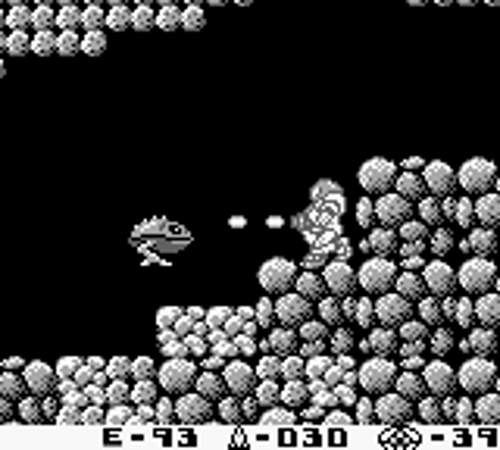
Since the original Metroid left such a lasting impression, expectations for Metroid II were inevitably high. Unsatisfied with the smaller screen and faintly streamlined experience, a good number of devoted fans of the first game quickly wrote this one off as being nothing more than a footnote barely worth mentioning. However, the truth of the matter is that Metroid II is one of—if not, the most important game in the series because it introduced a host of improvements and features that have become a mainstay ever since.
Essentially, you have to scour a large area of SR388 and hunt down all 39 Metroids, destroying them one-by-one. Samus must also defend herself from other native creatures of SR388. Much like the first game, there is one big hub world that interconnects smaller sub-sections that you must explore to snuff out each Metroid. Samus’ travel is somewhat limited throughout the game due to hazardous lava that drains her energy if touched and therefore prevents entry into the deeper sub-sections initially. The key to accessing those areas is defeating a fixed number of Metroids in your current area which will then trigger an earthquake and progressively drain the lava.
Over the course of the game, the Metroids undergo several rather ugly transformations. There are four types—Alpha, Zeta, Gamma, and Omega. Alpha Metroids can be easily destroyed with five missile shots. But by the time you discover the beefed up Omega Metroids, you’ll have to sink around 40 missiles into those behemoths to take them down. The Gamma and Omega varieties are especially dangerous because, unlike their lower forms, you can’t outrun them without leaving the room entirely if you need to take a breather in the heat of battle.
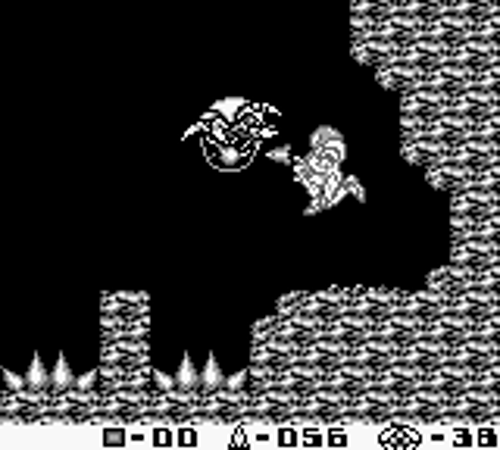
The game also manages to throw in a few jump scares now and then since some Metroids are either cleverly hidden or otherwise positioned in areas where they'll emerge suddenly. During each encounter, the battle music abruptly interrupts the often quite surroundings. Once you hear it, especially if caught off guard, it's hard not to feel a sense of urgent anxiety. And if you spook easy as I do, you may find yourself slowly tapping the directional pad, trying to inch along the screen to see if you spot one of them before the music kicks in.
This game had many improvements that are noticeable in several key areas. First, Samus was given a more robust set of basic moves and abilities. She starts off in the game with the Morph Ball, Long Beam, and a decent stock of missiles already, giving the game a feel of continuity from the first one. Controlling Samus felt much more precise now that she can also crouch to shoot low lying enemies as well as shoot downward when in mid-air. These small improvements went a long way to make Samus more of a competently equipped character.
Second, the newer weapons and items found throughout the game are much more helpful to you. The Bombs, High Jump Boots, Ice Beam, and Wave Beam return from the original; followed by the new tri-splitting Spazer Beam and the powerful Plasma Beam- great for making short work of the bigger common enemies. The game also introduces the Spider Ball for scaling any surface, the Spring Ball that allows Samus to jump while in Morph Ball mode, and the Space Jump which permits her to infinitely perform propelled jumps if timed correctly. When combined with the Screw Attack, she is practically invincible in mid-air. The design team was smart to create these items in the game because they eliminated the sometimes grueling aspect of getting around in the previous game.
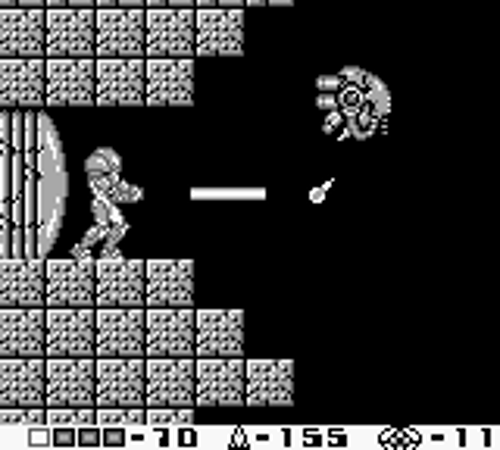
Also new to the series are save stations for- you guessed it- saving your progress. No more having to copy lengthy passwords or suffering the frustration of realizing that you wrote down an incorrect character when you tried to continue your adventure the next day. Better yet, the save stations kept an accurate record of your energy instead of reducing it back to 30 points like in the previous game. Additionally, there are missile and energy depots that completely refill your stock. They’re great to have around since Samus can hold up to 500 energy points and over 200 missiles. These new additions allow you to keep moving at a decent pace without having to spend extra time spamming enemies for replenishment.
Another significant improvement could be seen in the game’s visual presentation. The Nintendo R&D1 team needed to overcome the limited black-and-white display of the Game Boy screen. So they made Samus’ power suit more detailed with individual plating and sections of armor more distinguishable than before. When pressing the Select button to use the missiles, the barrel of her arm cannon pops open to indicate a difference in weapon mode. The most notable change comes when you obtain the Varia Suit. Samus gains rounded metal shoulder plating and bulky armor throughout the rest of the suit. She even runs a bit faster post-upgrade. Ever this redesign, the power suits began to make more sense visually and has been her signature look for the past two decades with few deviations.
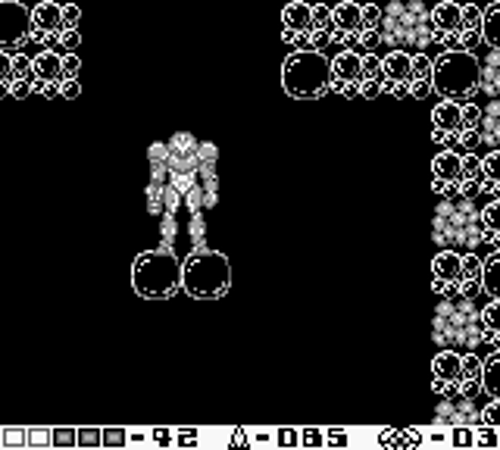
The audio style, in most respects, is a major departure from was composed in the previous game. Initially, things don’t sound all that different as you start off exploring the upper surface areas of the planet. But once you get into the sub-areas, the music is replaced with background ambiance that has a very alien feel to it. While certain sections do feature fully composed music (like the areas where you get upgrades), the game is mostly dominated by the minimalistic ambient noise. While this choice of audio design did not appeal to everyone, it still contributed to the feeling of creepy solitude that surrounds Samus for most of the game.
Metroid II was a risky sequel to be put on a small, color-deprived handheld at the time. But it was still a successful move for the most part. While some have scoffed at the more linear design of SR388, it was a welcome change for anyone who found the exploration in the previous Metroid game to be too cryptic at times. Most importantly, this game introduced necessary innovations for the series that may not have been as well conceived had it not been released on the Game Boy at all.







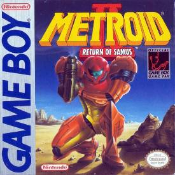


Comments